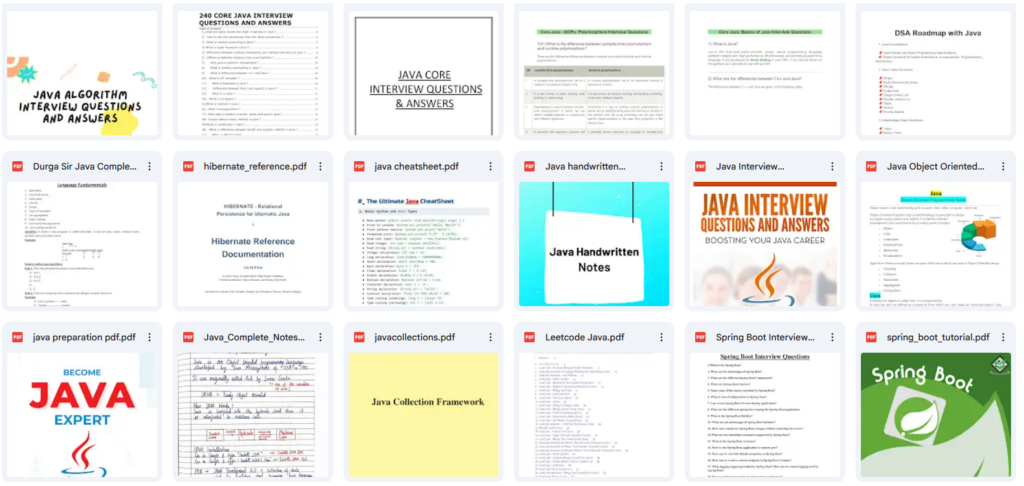
Java Handwritten Notes, Interview Questions, CheatSheet, Spring Boot & Hibernate Resources
Java has been a backbone of software development for years. Whether you’re new to programming or getting ready for interviews, Java has a lot to offer. In this post, we’ll cover the essentials , key concepts, architecture, useful resources like handwritten notes and cheat sheets, plus a set of curated interview questions to help you prepare.
1. Why Java?
Java is a general-purpose, statically typed, object-oriented language compiled to bytecode that runs on the Java Virtual Machine (JVM).
Its mantra is Write Once, Run Anywhere (WORA) — meaning your compiled bytecode can run on any JVM-enabled system without recompilation.
Key Strengths
- Platform independence via JVM + bytecode.
- Rich ecosystem: standard libraries, frameworks (Spring, Hibernate, etc.).
- Strong tooling: IDEs, build tools, debugging, profiling.
- Large community, abundant learning resources, and demand in the industry.
- Robustness features: memory management, exception handling, security model.
Challenges / Trade-offs
- Performance overhead vs low-level languages due to abstraction.
- Verbose syntax compared to newer languages.
- JVM tuning and garbage collection quirks for large systems.
- Complexity in large enterprise systems (dependency hell, versioning, etc.).
2. Java Platform Architecture
Java’s architecture has two major dimensions: the platform architecture (JVM, JRE, JDK) and the application architecture (how your code is organized).
Platform Components
- JDK (Java Development Kit): compiler (
javac), tools, APIs. - JRE (Java Runtime Environment): JVM + standard libraries needed to run Java programs.
- JVM (Java Virtual Machine): executes bytecode, manages memory (heap, stack), class loading, JIT, garbage collection.
How It Works: From Code to Execution
- You write
.javasource files. javaccompiles them into.classfiles (bytecode).- JVM loads classes, verifies, JIT-compiles hotspots.
- Bytecode executes on the target platform with memory + GC management.
Application Architecture Patterns
- Layered (presentation / service / data access)
- MVC (Model-View-Controller) for web apps
- Microservices & modularization
- Event-driven / message-based architectures
- Domain-driven design, hexagonal architecture
3. Core Java Fundamentals
3.1 Syntax, Types & Variables
- Primitive types:
int,long,float,boolean,char, etc. - Reference types: objects, arrays, interfaces.
- Scope: local, instance, static.
3.2 Control Flow & Operators
if-else,switch,for,while,do-while.- Operators: arithmetic, relational, logical, bitwise.
3.3 Methods / Functions
- Overloading: compile-time polymorphism.
- Overriding: runtime polymorphism via inheritance.
3.4 OOPS Principles
- Encapsulation – private fields, public getters/setters.
- Abstraction – interfaces, abstract classes.
- Inheritance –
extends, “is-a” relationships. - Polymorphism – overriding, interface polymorphism.
3.5 Exception Handling
- Checked vs unchecked exceptions.
try-catch-finally,throw,throws, try-with-resources.
3.6 Collections & Generics
- Collections Framework: List, Set, Map, Queue.
- Generics provide compile-time type safety.
3.7 Concurrency & Threads
- Built-in threading (
Thread,Runnable). java.util.concurrentutilities: locks, executors, atomics.
3.8 Miscellaneous
- I/O (java.io, java.nio).
- Streams & lambdas (Java 8+).
- Serialization, reflection, annotations.
4. Advanced Topics & Modern Enhancements
Garbage Collection & Memory
- Algorithms: G1, ZGC, Shenandoah, etc.
JIT Compilation
- Hotspot JIT, optimizations like inlining, loop unrolling, escape analysis.
Java Module System
- Introduced in Java 9:
requires,exportsfor modular packaging.
Future of Java
- Project Valhalla: value classes, null-restricted types, primitive generics.
App Architecture Trends
- Microservices, reactive programming, event-driven design, cloud-native Java.
5. Helpful Java Resources

- 📄 Java Handwritten Notes
- 📄 Java CheatSheet
- 📄 Java OOPS Notes
- 📄 240 Core Java Interview Q&A
- 📄 Java Collection Framework Notes
- 📄 Java LeetCode Questions with Answers
- 📄 Java Algorithm Interview Questions
- 📄 Spring Boot Notes
- 📄 Spring Boot Interview Q&A
- 📄 Hibernate Notes
To get the direct Drive link you can get here – Link
6. Sample Java Interview Questions (with hints)
- Difference between
==andequals()?==→ reference equality.equals()→ logical equality (overridable). - Explain Java memory model (heap, stack, method area, PC).
- Heap: objects
- Stack: method frames
- Method area: class metadata
- PC register: thread execution pointer
- What is the diamond problem?
- Java prevents multiple inheritance of implementation.
- Solved via interfaces (default methods).
- How do generics work with type erasure?
- Type info removed at runtime, replaced with raw types/bounds.
- HashMap vs TreeMap vs LinkedHashMap?
- HashMap: unordered.
- TreeMap: sorted keys.
- LinkedHashMap: insertion-order.
synchronizedvsReentrantLock?ReentrantLock→ fairness, tryLock, interruptible locks.
- How does GC find live objects?
- Reachability from GC roots (strong/weak/soft/phantom refs).
- Checked vs Unchecked exceptions?
- Checked → must declare/catch.
- Unchecked → runtime exceptions/errors.
7. Tips for Learning & Revision
- Practice coding daily (mini projects, coding platforms).
- Revise with your cheat sheet regularly.
- Use flashcards for OOPS & Collections concepts.
- Teach/blog concepts to cement learning.
- Mock interviews with a timer.
- Stay updated with latest Java features (JDK 17, 21, etc.).
At Last
Java is vast, but structured learning + continuous practice + solid revision materials (like your handwritten notes, cheat sheets, and interview question bank) make mastery achievable.
👉 Use the resources linked above to build your foundation, strengthen your preparation, and ace interviews.
Join Telegram group for more resources & discussions!
🧰 Useful Resources for Your Placement Prep
- ✅ Free Mock Test
- ✅ ATS Score Checker & Resume Optimizer
- ✅ Previous Year Coding Questions (PYQs)
- ✅ Roadmaps
- ✅ Interview Questions
- ✅ Interview Experience
- ✅ Resume Templates
- ✅ Free Placement Materials (Google Drive)
- ✅ 3000+ Startups List for job seekers
Previous:
Components
Next:
Lets Code
Contributing Writer